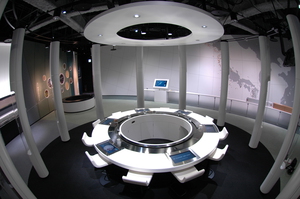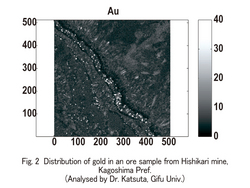Nagoya City Science Museum
TOP > Exhibition Guide > Floor Map> Boring cores
Boring cores

Purpose of Exhibition
This exhibition shows how and what scientists read from the rocks and stratums which are taken out from underground as boring-cores, and enjoying the best results from their research.


Additional Knowledge
[Revealing the past from the stratum]
Let's see the boring-core under the Nagoya City Science Museum. There are melted glass bottles included in the top layer. It means that there were glass bottles when the stratum was made and the temperature was high enough for them to melt. It could be that this is a war-damaged artifact. The second layer from the top is the stratum from around the Middle Ages because there are some types of potteries of the time. The third layer from the top is in the Kofun Period. The fourth layer from the top is in the Jomon Period. Researching the cumulated stratums is a way of estimating the past from buried artifacts.
[Small fossil works]
"Micro fossils" are important as a clue to the past, because it is rare to find a big fossil in the boring core whose diameter is only several centimeters. They are tiny fossils of just a few millimeters big such as the shells of planktons (foraminifera, diatom and radiolarian) as well as pollen and spores. We can specify the ages if we identify species of micro-fossils which distributes a range of wide areas in a short period (index fossil). We can also know the environment (air temperature, water temperature, and salinity etc.) at the time because the living environment of plankton and pollen are different (facies fossil). Moreover, by using oxygen-isotopes of micro fossils, we can estimate the temperature at the time.
(Figure1)
[Interesting boundary]
Other than sediments (the rock), there are igneous rocks that solidified the magma and metamorphic rocks that are recrystallized at high temperature and pressure. If the sediments and the rocks that were made differently contact each other, it means that there was an era gap between them. For example, if the igneous rocks and the metamorphic rocks contacted, there are three possibilities. First is that the sediments were accumulated after the magma became solid and cooled down. Second is that the magma came into after the sediments become hard. Third is that the rock ground was moved over because of faults in the earth. Scientists are interested in the boundary division of the different forms of rock tangent because it is the record of some sort of past phenomenon.
[Investigating the underground through various analyses]
Several analyses of boring-cores are done according to research purposes. When we research the rocks, we basically use a polarizing microscope. We can know what kinds of minerals are included and what structure they have. According to the circumstances, we analyze what components exist and how much are included. Porosity, granularity, and fracture density are measured to investigate the strength and how easy or difficult is for groundwater to pass through. Boring core is a useful specimen because it can research the underground that we usually cannot see.
For monitoring the state of the underground environment, the water level sensor and seismometer are set up in the bored holes. There is a way of picking the underground springing into a bored pit to analyze the dissolved components. These analyses contribute to research of environmental conditions of the underground.
Article by Shoji Nishimoto, curator
